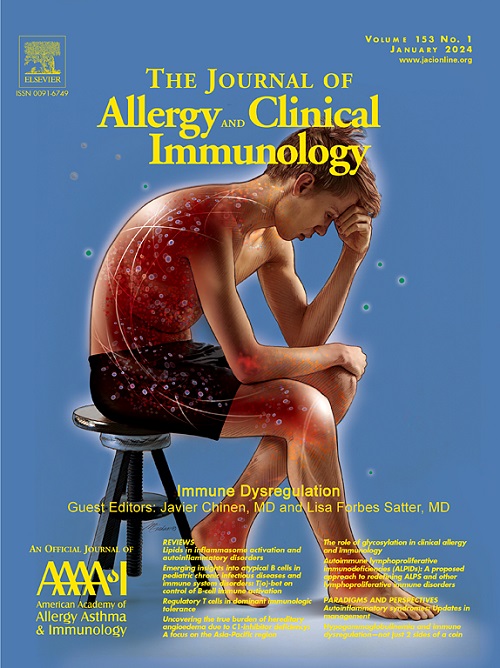接种辉瑞- biontech mRNA疫苗BNT162b2后的纵向T细胞和B细胞回忆反应。
IF 11.2
1区 医学
Q1 ALLERGY
引用次数: 0
摘要
sars - cov -2引发了一场大流行,导致数百万患者死亡。针对SARS-CoV-2 (BNT162b2)的辉瑞- biontech mRNA疫苗诱导抗原特异性T细胞和B细胞的发育,这与疾病保护相关。然而,他们在重新激活后建立真实回忆反应的能力并没有得到解决。目的确定接种BNT162b2疫苗后T细胞和B细胞召回反应的持续时间、强度和表型。方法12例接种了BNT162b2疫苗的受试者纳入本研究。在给予初始剂量前、初始剂量后21天以及加强剂量后1、3、6和9个月采集6份血液样本。在体外刺激抗原特异性B细胞和T细胞,分析它们的丰度、寿命、表型和召回反应的强度。活化B细胞的血浆和上清用于测定抗原特异性免疫球蛋白的水平、动力学和中和电位。结果BNT162b2疫苗接种可产生持久的中和性免疫球蛋白,以及抗原特异性记忆CD4+ T细胞,这些细胞在再激活后增殖,促进保护性Th1反应,并诱导抗原特异性记忆B细胞中的IgG/IgA类转换,这些细胞在再激活后分泌中和抗体。此外,抗原特异性记忆CD8+ T细胞在再激活后增殖并上调颗粒酶和穿孔素以消除感染细胞。结论:接种BNT162b2疫苗可诱导刺突特异性记忆T细胞和B细胞,这些细胞在抗原暴露后被重新激活,从而产生召回反应,在免疫后长达9个月的时间内保护人们免受SARS-CoV-2感染。本文章由计算机程序翻译,如有差异,请以英文原文为准。
Longitudinal T and B cell recall responses following vaccination with the Pfizer-BioNTech mRNA vaccine BNT162b2.
BACKGROUND
SARS-CoV-2 caused a pandemic that resulted in the death of millions of patients. The Pfizer-BioNTech mRNA vaccine against SARS-CoV-2 (BNT162b2) induced the development of antigen-specific T and B cells, which correlated with protection from disease. However, their ability to mount a true recall response following reactivation was not addressed.
OBJECTIVE
To determine the longevity, intensity, and phenotype of the T and B cell recall responses following vaccination with BNT162b2.
METHODS
Twelve participants vaccinated with BNT162b2 were included in this study. Six blood samples were collected prior to administering the prime dose, 21 days after the prime dose, and 1, 3, 6, and 9 months post-booster dose. Antigen-specific B and T cells were stimulated ex vivo, and their abundance, longevity, phenotype, and intensity of their recall responses were analyzed. Plasma and supernatant of activated B cells were used to determine the levels, kinetics, and neutralization potential of antigen-specific immunoglobulins.
RESULTS
Vaccination with BNT162b2 resulted in the development of long-lasting neutralizing immunoglobulins, as well as antigen-specific memory CD4+ T cells that proliferate upon reactivation, promote a protective Th1 response, and induce IgG/IgA class switching in antigen-specific memory B cells, which are primed to secrete neutralizing antibodies upon reactivation. Additionally, antigen-specific memory CD8+ T cells proliferate upon reactivation and upregulate granzyme and perforin to eliminate infected cells.
CONCLUSION
Vaccination with BNT162b2 induces spike-specific memory T and B cells that are reactivated upon antigen exposure to mount a recall response that protects from SARS-CoV-2 infection for up to 9 months after immunization.
求助全文
通过发布文献求助,成功后即可免费获取论文全文。
去求助
来源期刊
CiteScore
25.90
自引率
7.70%
发文量
1302
审稿时长
38 days
期刊介绍:
The Journal of Allergy and Clinical Immunology is a prestigious publication that features groundbreaking research in the fields of Allergy, Asthma, and Immunology. This influential journal publishes high-impact research papers that explore various topics, including asthma, food allergy, allergic rhinitis, atopic dermatitis, primary immune deficiencies, occupational and environmental allergy, and other allergic and immunologic diseases. The articles not only report on clinical trials and mechanistic studies but also provide insights into novel therapies, underlying mechanisms, and important discoveries that contribute to our understanding of these diseases. By sharing this valuable information, the journal aims to enhance the diagnosis and management of patients in the future.

 求助内容:
求助内容: 应助结果提醒方式:
应助结果提醒方式:


